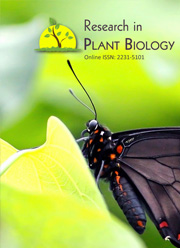An assessment of heavy metal accumulation in mangrove species of Bhitarkanika, Odisha, India
Keywords:
Bhitarkanika, Heavy metal, Mangroves, SedimentAbstract
Mangroves are one of the most biologically important and productive ecosystemsin the world. Heavy metals are known to pose a potential threat to terrestrial and aquaticbiota. However, little is known on the toxic levels of heavy metals found in mangroveplants in India. To understand heavy metal toxicity, we analyzed heavy metalsaccumulation in sediment samples collected from surrounding root zone and in the leavesand stem of sixteen different plant species in the Bhitarkanika mangrove forest reserve inOdisha, India. Bhitarkanika mangrove ecosystem receives heavy metal pollution fromupstream areas of Brahmani and Baitarani estuary. Few studies were carried about thecapacity of mangrove plants to take up and store heavy metals in them. Hence, currentinvestigation was carried out to analyze trace metal accumulation in sediment and plantparts such as stems and leaves of different mangrove plants by Atomic AbsorptionSpectroscopy (Shimadzu, AA- 6300). The heavy metal concentration in sediment wasfound to be in the range of 5.99 to 92.00 μg/gm. Metals concentration in sediment samplesduring the study was in the order of accumulation : Zn>Cu>Pb. The accumulation ofheavy metal was higher in stem as compared to leaf.Downloads
Download data is not yet available.
Published
20-12-2013
How to Cite
Panda, S. S., Chaturvedi, N., Dhal, N. K., & Rout, N. C. (2013). An assessment of heavy metal accumulation in mangrove species of Bhitarkanika, Odisha, India. Research in Plant Biology, 3(6). Retrieved from https://updatepublishing.com/journal/index.php/ripb/article/view/2489
Issue
Section
Articles



 .
. 